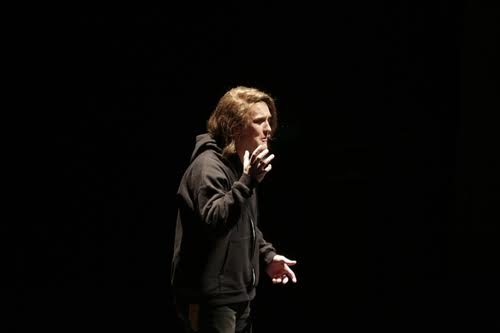
More than 900 audience members experienced the modern-dress production of Shakespeare's famous "Hamlet" put on by the Holy Cross theatre department during two consecutive April weekends in Fenwick Theatre. Fittingly, the final performance fell on the 400th anniversary of Shakespeare's death.
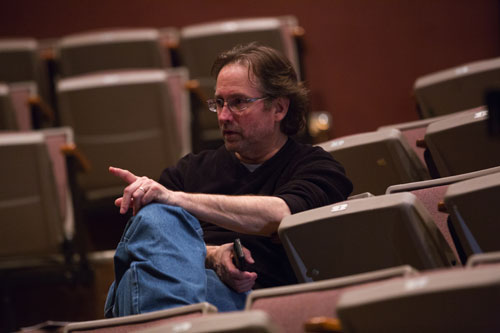 |
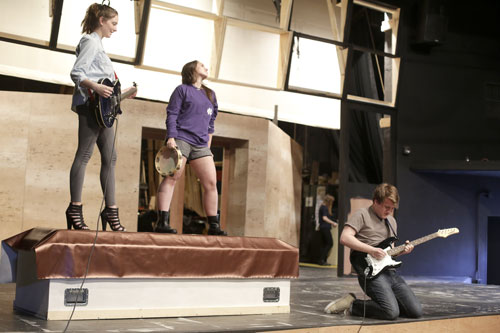 |
| The play was infused with modern touches, including electric guitars and tambourines played by (above, left to right) Emma Linsenmeyer '16 (Rosencrantz), Alexis Rappaport '19 (Guildenstern) and Brian Ott '16 (Hamlet). "A modern dress production offers opportunities to create resonance between the seemingly archaic language of Shakespeare—that often feels stilted and foreign to our ears—and the immediacy of the action that speaks directly to our contemporary experience," Isser shared. "It allows us to surprise, shock and entertain an audience that is provoked into seeing the play anew with fresh eyes." |
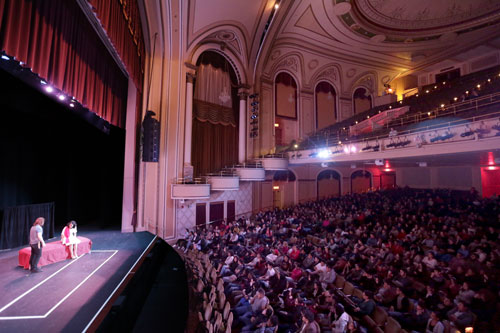 |
| Before being staged at Holy Cross, the first full production of the play was put on at the Hanover Theatre in Worcester on March 31 for roughly 1000 students from the Worcester School District. "Performing 'Hamlet' at the Hanover served the community, provided a unique training opportunity for Holy Cross students, and hopefully energized and excited a new generation of young people to the wonder and power of Shakespearean performance," said Isser. |
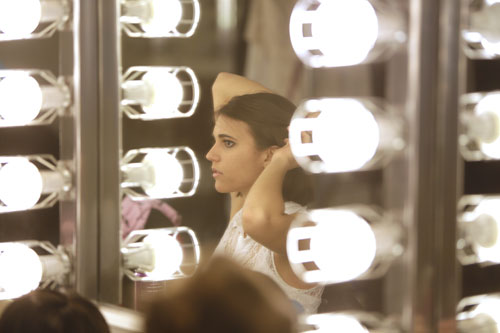 |
| "We half-expected the high school audience to fall asleep partway through, especially since we started the show at 9 a.m.," said Alison Christovich '18, a member of the cast ensemble, shown above getting ready backstage at the Hanover. "But they laughed when Gertrude died with the brief line 'I am poisoned,' then they clapped when Claudius finally got what he deserved." The Hanover performance, which ended with roaring applause, gave the cast motivation which carried them through the closing night of the show, Christovich shared. |
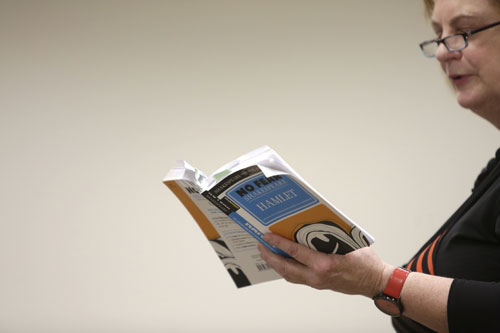 |
|
"Hamlet" also seeped into classrooms across campus, from Montserrat clusters to English classes, as Holy Cross students studied the play in preparation for seeing it staged by the theatre department; this included the Critical Reading and Writing course taught by Helen Whall, professor of English (above). |
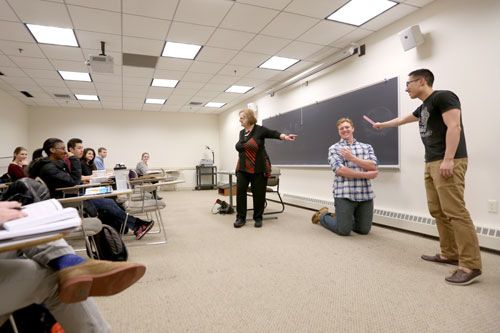 |
| Whall's students formally analyzed the text while also having fun with it, reenacting the scene described by the Player King in which Pyrrhus freezes the sword above Priam’s ear, played (above, left to right) by Jeffrey Dickinson '19 and Yun Hu '18 in front of their classmates. The impromptu in-class performance began bringing the text to life, leading the students up to the staged production, which they saw together during its first week at the Fenwick Theatre. "Since drama is meant to be enacted, watching the performance added a new dimension to the class by being able to enjoy the play in the medium for which it was written," says Galen Comerford '19, a member of Whall's class. "I was surprised by the modernizations, but I think they made the play more accessible to audiences." |
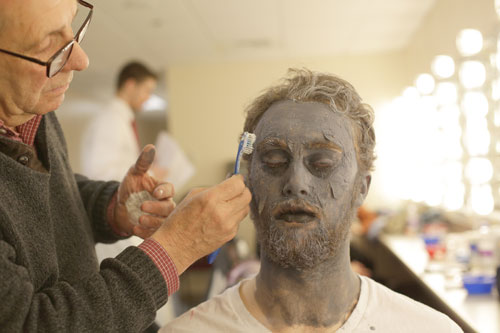 |
| The costume design, led by Kurt Hultgren, visually supported Isser's mission of modernizing the roughly 400 year old play. Hultgren is shown (above) backstage, applying a combination of latex with wrinkled tissues and liquid makeup to Adam DeCoste '19, who played the ghost of Hamlet's father — a process which took about an hour for each performance. |
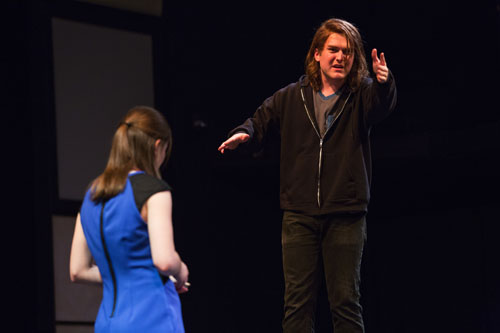 |
| "I am most interested in giving actors clothes that help to define the characters," explains Hultgren. While Hamlet, played by Brian Ott '16 (above), was delivering his famous "Get thee to a nunnery" lines to Ophelia in early modern English, his jeans and hoodie, long hair and tired eyes, made his lines resonate with contemporary audiences with renewed energy. |
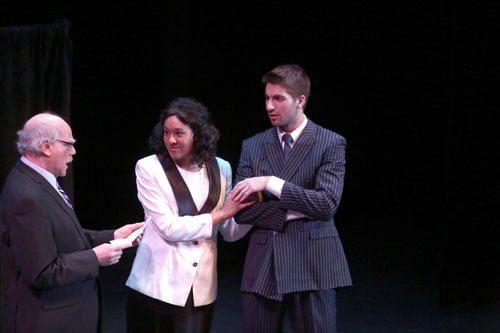 |
| Behind the scenes, the cast gave credit to Isser's direction for bringing the characters to life. "Looking back, my favorite part of this journey was watching and being part of the show's evolution. It's incredible how the play developed, and our interpretations of the character's changed as we grew more comfortable with Shakespeare's language and began to grasp professor Isser's vision for the play," said Erik Schneider '16, who played Claudius (above, right), next to Rebekah Dowdell '16, who played Gertrude (above, middle). |
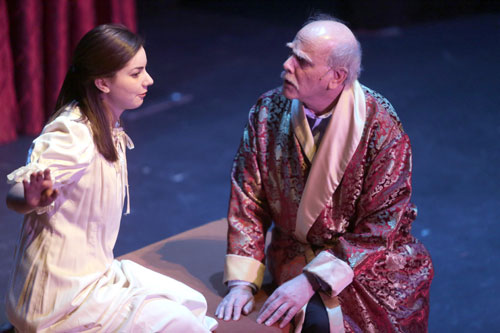 |
| The show included another faculty member from the theatre department, Steve Vineberg, professor of theatre, who played Polonius (above, left) alongside Rosemary Weiss '18, who played his daughter, Ophelia. This was not Weiss' first interaction with Vineberg, however: "I have been directed by Steve Vineberg — I played Flo in his production of 'Picnic' (Spring 2015) — and also took a 'British Theatre in Perspective' course in London through a Maymester program taught by him and Ed Isser. We know each other well and it was a treat acting with him. I hope one day we can play a father-daughter duo again — perhaps King Lear and Cordelia — or maybe I'll direct him." |
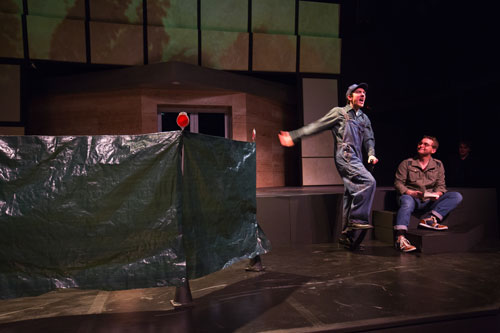 |
| While "Hamlet" is often known as a tragedy, this production didn't shy away from highlighting the play’s comedic moments — for instance the surprisingly pun-filled conversation about death and drowning between the grave digger (Daniel Taylor '19, above, left), Horatio (Patrick O’Konis '16, above, right), and Hamlet (Brian Ott '16, not pictured). "These moments of humor are peppered throughout the show, ranging from complex quips — as in the previous example — to bawdy, crass jokes," said Ott. "Finding these moments was crucial to connecting with our audience and really helping them to understand and become invested in the plot." |
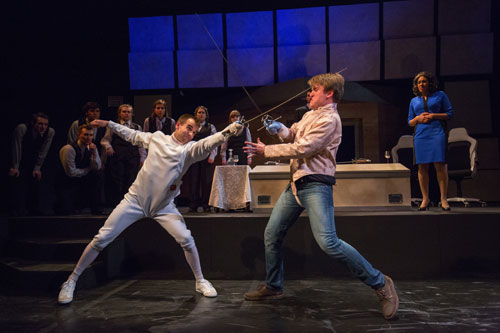 |
| The 18-person cast of "Hamlet" had a dynamic learning experience — from understanding the lines of the play to how to best perform them — that culminated in an impressive production. "The Fenwick Theatre serves as a laboratory for the Department of Theatre and production work is an extension of our classroom exploration," said Isser. |
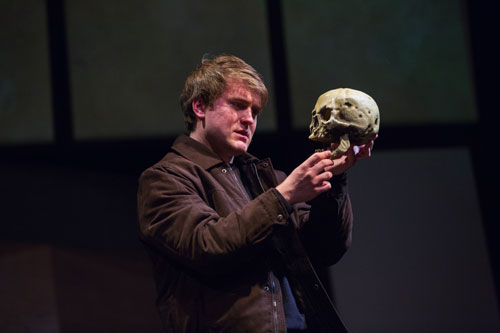 |
| From Hamlet's famous "To be or not to be" soliloquy to his iconic "Alas, poor Yorick!" speech (above), the theatre department's modern-dress production of the play brought new audiences into the rotten Denmark, only to discover that Hamlet's struggles — although marked with kings and swordfights — are not so far from our own.
|
Images by Dan Vaillancourt and Tom Rettig

